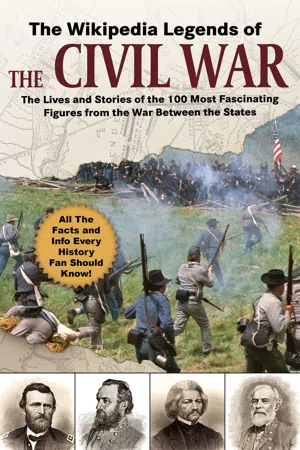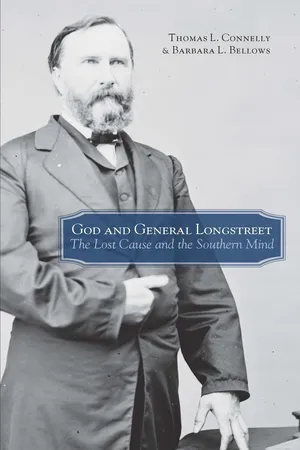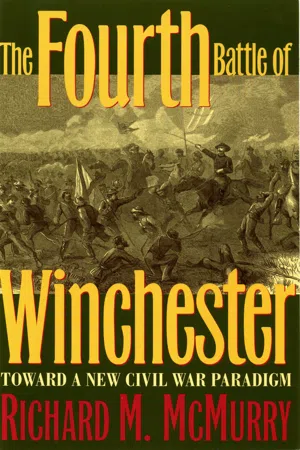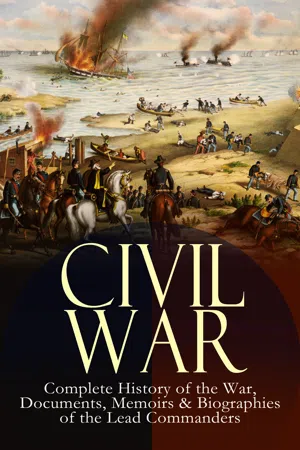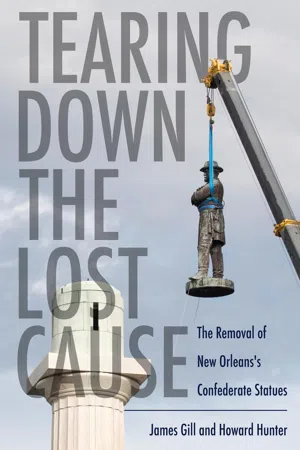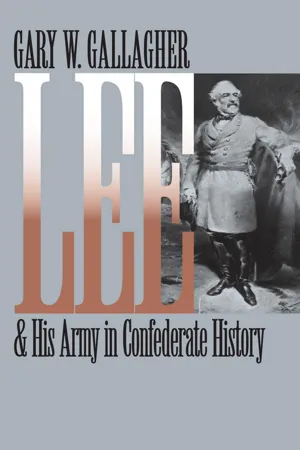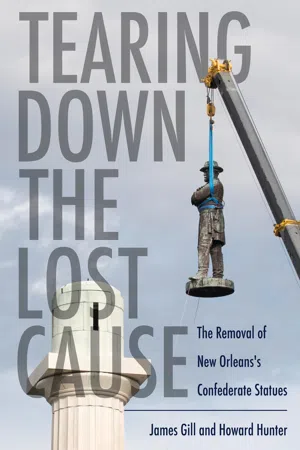History
Robert E Lee
Robert E. Lee was a Confederate general during the American Civil War. He is known for his military leadership and tactical skills, as well as his decision to surrender to Union General Ulysses S. Grant at Appomattox Court House, effectively ending the war. Despite his role in the Confederacy, Lee is still widely respected for his character and leadership abilities.
Written by Perlego with AI-assistance
Related key terms
1 of 5
10 Key excerpts on "Robert E Lee"
- eBook - ePub
The Wikipedia Legends of the Civil War
The Incredible Stories of the 75 Most Fascinating Figures from the War Between the States
- (Author)
- 2020(Publication Date)
- Skyhorse(Publisher)
Robert E. Lee
Lee in March 1864Robert Edward Lee (January 19, 1807–October 12, 1870) was an American and Confederate soldier, best known as a commander of the Confederate States Army. He commanded the Army of Northern Virginia in the American Civil War from 1862 until its surrender in 1865.A son of Revolutionary War officer Henry “Light Horse Harry” Lee III, Lee was a top graduate of the United States Military Academy and an exceptional officer and military engineer in the United States Army for 32 years. During this time, he served throughout the United States, distinguished himself during the Mexican–American War, and served as Superintendent of the United States Military Academy. He was also the husband of Mary Anna Custis Lee, adopted great granddaughter of George Washington.When Virginia’s 1861 Richmond Convention declared secession from the Union, Lee chose to follow his home state, despite his desire for the country to remain intact and an offer of a senior Union command.[1] During the first year of the Civil War, he served as a senior military adviser to Confederate President Jefferson Davis. Once he took command of the Army of Northern Virginia in 1862, he soon emerged as an able tactician and battlefield commander, winning most of his battles, nearly all against far larger Union armies.[2][3]Lee’s two major strategic offensives into Union territory ended in defeat.[4][5][6] His aggressive tactics, especially at the Battle of Gettysburg, which resulted in high casualties at a time when the Confederacy had a shortage of manpower, have come under criticism in recent years.[7]Lee surrendered the remnant of his army to Ulysses S. Grant at Appomattox Court House on April 9, 1865. Since Confederate Congress had appointed him supreme commander of Confederate armies, the remaining Confederate forces capitulated after his surrender. Lee rejected the proposal of a sustained insurgency against the Union and called for national reconciliation. - eBook - ePub
God and General Longstreet
The Lost Cause and the Southern Mind
- Thomas Lawrence Connelly, Barbara L. Bellows(Authors)
- 1995(Publication Date)
- LSU Press(Publisher)
Chapter ThreeROBERT E. LEE AND THE SOUTHERN MIND
We know so much about him, or at least we believe we do. By the measure of most prominent men, there should be nothing left to tell of the private life and military feats of Robert E. Lee.What else can be told of one so awesome that his shadow falls across the entire southern presence in American life? We know of his early, dutiful attendance to an ailing mother, a model record at the military academy, and a pattern of abstemious habits molded early in life. Anyone who has read of Robert E. Lee can recite other parts of that canon of devotion to the supreme southern hero symbol.There was his marriage to Mary Custis, the “child of Arlington,” and the subsequent decades of devotion to a sickly wife. One reads of Lee’s skill and courage in the difficult campaign from Vera Cruz to Mexico City, when his daring and judgment forever earned him the admiration of General Winfield Scott.The Mexican War and its newspaper accolades passed, and eventually many destined for later greatness in the Civil War grew weary of slow promotion, low pay, and dusty outpost duty. Ulysses Grant, William Sherman, George Meade, P. G. T. Beauregard—all ventured into civilian life. We know that Lee remained for well over a decade in a tedious, often lonely existence that tested his resolve early. His letters during these years are in the public domain and have been printed in scores of books. He languished over absence from his ailing wife and his beloved Virginia soil. Lee fretted about his inability to supervise more closely the daily temptations that beset a gathering brood of seven children. So he often wrote letters to his offspring, urging them to adopt a code of Christian service and duty, to mind their manners and recite prayers. The once private messages from a father to his children are now a matter of public record.We know that Robert E. Lee himself uttered prayers daily and demonstrated other mannerisms of a Christian gentleman. Grammar school children in Alabama a half-century ago could recite those Lee traits that still evoke admiration even from the pens of skeptics. For a New South generation, Lee epitomized duty, humility, self-denial, and practice of self-control. - eBook - ePub
The Fourth Battle of Winchester
Toward a New Civil War Paradigm
- Richard McMurry(Author)
- 2013(Publication Date)
- The Kent State University Press(Publisher)
PART SIXRobert E. Lee andthe Confederacy’s Conductof the War
Passage contains an image
O ver the last three or four decades, what was once virtually unthinkable in Civil War circles has become fairly common. Writers who dare to take a critical attitude toward Gen. Robert E. Lee have come out of the closet and created what amounts to a cottage industry dedicated to the production of books and articles in which they take the great Confederate commander to task for one or more of a large number of alleged weaknesses, flaws, faults, and character, psychological, or personality disorders. These assorted liabilities, they assert, explain not only the defeat of Lee’s army in Virginia but also the ultimate failure of the Confederacy’s bid for independence. Only recently have Lee’s advocates rallied to mount an effective countereffort in the general’s behalf.For more than half a century after his death in October 1870, Robert E. Lee, in the words of writer Lamont Buchanan, “rode serenely along” high above the storm of historical debate that swirled constantly about almost all the other major figures of the 1861–65 period. Lee, Buchanan noted, had been “respected even by those who opposed the cause he served.”1Lee acquired, first, the status of a (really the) great hero of the white South, and then after several decades he became also a major national figure, admired and respected by almost all white Americans, North and South, for his high personal character, flawless life, and unquestioned personal integrity. During those decades almost all commentators on the Civil War also pronounced him the conflict’s greatest military genius and one of the few truly great military commanders in the nation’s, if not the world’s, history.This view of Lee was in large part reality. After all, he was a very good general as well as a man of extraordinary personal integrity, intelligence, and ability. In part too this view stemmed from the ceaseless post-1870 activities of such often overlapping groups as the Lee Memorial Association, “Early and company,” the Southern Historical Society, the United Confederate Veterans, the Confederated Southern Memorial Association, the United Daughters of the Confederacy, and the Sons of Confederate Veterans. - eBook - ePub
CIVIL WAR – Complete History of the War, Documents, Memoirs & Biographies of the Lead Commanders
Memoirs and Documents of the Civil War Era
- Abraham Lincoln, Ulysses S. Grant, William T. Sherman, James Ford Rhodes, John Esten Cooke, Frank H. Alfriend(Authors)
- 2017(Publication Date)
- Madison & Adams Press(Publisher)
"Even amid the turmoil of the great European struggle, the intelligence from America announcing that General Robert E. Lee is dead, will be received with deep sorrow by many in this country, as well as by his followers and fellow-soldiers in America. It is but a few years since Robert E. Lee ranked among the great men of the present time. He was the able soldier of the Southern Confederacy, the bulwark of her northern frontier, the obstacle to the advance of the Federal armies, and the leader who twice threatened, by the capture of Washington, to turn the tide of success, and to accomplish a revolution which would have changed the destiny of the United States. Six years passed by, and then we heard that he was dying at an obscure town in Virginia, where, since the collapse of the Confederacy, he had been acting as a school-master. When, at the head of the last eight thousand of his valiant army, the remnants which battle, sickness, and famine had left him, he delivered up his sword to General Grant at Appomattox Court-House, his public career ended; he passed away from men's thoughts; and few in Europe cared to inquire the fate of the general whose exploits had aroused the wonder of neutrals and belligerents, and whose noble character had excited the admiration of even the most bitter of his political enemies. If, however, success is not always to be accounted as the sole foundation of renown, General Lee's life and career deserve to be held in reverence by all who admire the talents of a general and the noblest qualities of a soldier. His family were well known in Virginia. Descended from the Cavaliers who first colonized that State, they had produced more than one man who fought with distinction for their country. They were allied by marriage to Washington, and, previous to the recent war, were possessed of much wealth; General (then Colonel) Robert Lee residing, when not employed with his regiment, at Arlington Heights, one of the most beautiful places in the neighborhood of Washington. When the civil war first broke out, he was a colonel in the United States Army, who had served with distinction in Mexico, and was accounted among the best of the American officers. To him, as to others, the difficult choice presented itself, whether to take the side of his State, which had joined in the secession of the South, or to support the central Government. It is said that Lee debated the matter with General Scott, then Commander-in-chief, that both agreed that their first duty lay with their State, but that the former only put the theory into practice. - eBook - ePub
- John Esten Cooke(Author)
- 2004(Publication Date)
- Perlego(Publisher)
"Even amid the turmoil of the great European struggle, the intelligence from America announcing that General Robert E. Lee is dead, will be received with deep sorrow by many in this country, as well as by his followers and fellow-soldiers in America. It is but a few years since Robert E. Lee ranked among the great men of the present time. He was the able soldier of the Southern Confederacy, the bulwark of her northern frontier, the obstacle to the advance of the Federal armies, and the leader who twice threatened, by the capture of Washington, to turn the tide of success, and to accomplish a revolution which would have changed the destiny of the United States. Six years passed by, and then we heard that he was dying at an obscure town in Virginia, where, since the collapse of the Confederacy, he had been acting as a school-master. When, at the head of the last eight thousand of his valiant army, the remnants which battle, sickness, and famine had left him, he delivered up his sword to General Grant at Appomattox Court-House, his public career ended; he passed away from men's thoughts; and few in Europe cared to inquire the fate of the general whose exploits had aroused the wonder of neutrals and belligerents, and whose noble character had excited the admiration of even the most bitter of his political enemies. If, however, success is not always to be accounted as the sole foundation of renown, General Lee's life and career deserve to be held in reverence by all who admire the talents of a general and the noblest qualities of a soldier. His family were well known in Virginia. Descended from the Cavaliers who first colonized that State, they had produced more than one man who fought with distinction for their country. They were allied by marriage to Washington, and, previous to the recent war, were possessed of much wealth; General (then Colonel) Robert Lee residing, when not employed with his regiment, at Arlington Heights, one of the most beautiful places in the neighborhood of Washington. When the civil war first broke out, he was a colonel in the United States Army, who had served with distinction in Mexico, and was accounted among the best of the American officers. To him, as to others, the difficult choice presented itself, whether to take the side of his State, which had joined in the secession of the South, or to support the central Government. It is said that Lee debated the matter with General Scott, then Commander-in-chief, that both agreed that their first duty lay with their State, but that the former only put the theory into practice. - eBook - PDF
Tearing Down the Lost Cause
The Removal of New Orleans's Confederate Statues
- James Gill, Howard Hunter(Authors)
- 2021(Publication Date)
- University Press of Mississippi(Publisher)
Robert E. Lee 6 According to the Jung scholar Joseph L. Henderson, “As a general rule it can be said that the need for hero symbols arises when the ego needs strengthening.” 7 New Orleans had undergone a double humiliation, military defeat and Federal occupation from 1862 to 1877. Along with the rest of the South, Confederate veterans and partisans turned to the Lost Cause as a palliative. The narrative turned into a catechism—Southern valor and heroism were to be celebrated; secession was about a constitutional disagreement, with the South defending its rights as a sovereign state, and slavery a nonissue. In his own life, Robert E. Lee preferred to “obliterate the marks of civil strife” regarding memorials but became the patron saint of the Lost Cause. As a symbol, he assuaged Southern guilt and gave hope to the vanquished. He held a mirror up to the South, and later to the whole country, of a civilization lost only to be replaced by Gilded Age plutocrats and the avarice that defined the era. It was not a coincidence that the dedication took place on George Washington’s birthday. By the 1880s, southern apologists aggressively attempted to link the Confederacy to a national mythology through the Lee persona. Lee’s connections to Washington were legitimate, since his father was the Revolutionary War hero “Light-Horse Harry” Lee, who was a favorite of the commander in chief, and Lee the son married Mary Custis, the step-great-granddaughter of Washington. That Lee took up arms against the United States was a mere techni-cality. - eBook - ePub
Conflict and Command
Civil War History Readers, Volume 1
- John T. Hubbell(Author)
- 2011(Publication Date)
- The Kent State University Press(Publisher)
An Old-Fashioned Soldier in a Modern War? Robert E. Lee as Confederate General G ARY W. G ALLAGHER Civil War History, Vol. XLV No. 4 © 1999 by The Kent State University Press Much of the literature on the Civil War portrays Robert E. Lee as a grand anachronism. In a conflict often characterized, whether accurately or not, as the first great modern war, 1 the Confederate commander frequently appears as a soldier of considerable martial gifts who harkened back to an earlier time. Lee is cast as a man who thought of the struggle in terms of protecting his own state rather than advancing the cause of the entire Confederacy, forged a personal bond with his soldiers reminiscent of feudal relationships, focused on winning set-piece battles without taking in the broader political and social landscape of a modern war, and failed to understand the implications of new weaponry such as the rifle-musket. Historians and other writers have employed an array of images that tie Lee to a knightly tradition and an agrarian age, presenting him as a localist for whom kinship and ancestral place meant everything. This Lee functions as the perfect foil to Ulysses S. Grant and William Tecumseh Sherman, Union generals typically described as forward-looking officers who recognized the necessity of waging a modern war that engulfed entire societies, plotted their strategy accordingly, and changed the nature of the conflict. Two very different groups of authors have nourished the anachronistic image of Lee as an old-fashioned general: those who admire him and intend their chivalric portrayal to be positive, and those more hostile who describe a commander out of touch with much of the military reality of his time - eBook - ePub
- Gary W. Gallagher(Author)
- 2002(Publication Date)
- The University of North Carolina Press(Publisher)
83–102; Joseph P. Harsh, Confederate Tide Rising: Robert E. Lee and the Making of Southern Strategy, 1861–1862 (Kent, Ohio: Kent State University Press, 1998); and Joseph T. Glatthaar, Partners in Command: The Relationships between Leaders in the Civil War (New York: Free Press, 1994), chapter 2. See also Roland’s essay “The Generalship of Robert E. Lee,” in Grady McWhiney, ed., Grant, Lee, Lincoln and the Radicals: Essays on Civil War Leadership (n.p.: Northwestern University Press, 1964). Roland’s and Castel’s essays also may be found in Gallagher, ed., Lee the Soldier, 159–88, 209–24. The most detailed favorable interpretation of Lee’s generalship remains Douglas Southall Freeman, R. E. Lee: A Biography, 4 vols. (New York: Scribner’s, 1934–35), especially chapter 11 of volume 4. 19. April 24, 1865, interview with Lee by Thomas M. Cook, printed in the New York Herald, April 29, 1865. Cook, who admitted that he paraphrased Lee’s comments, also reported that the general believed the Constitutional Convention of 1787 left the issue of states’ rights unresolved. It would have been better if the question could have been settled peacefully, but, remarked Lee, “If the South is forced to submission in this contest, it of course can only be looked upon as the triumph of federal power over State rights, and the forced annihilation of the latter.” 20. Potter’s essay, “The Historian’s Use of Nationalism and Vice Versa,” first appeared in Alexander V. Riasonovsky and Barnes Riznik, eds., Generalizations in Historical Writing (Philadelphia: University of Pennsylvania Press, 1963), and was reprinted in Potter, The South and the Sectional Conflict (Baton Rouge: Louisiana State University Press, 1968). For expressions of loyalty to Virginia, the South, and the United States, see Lee’s letter (probably to his son Custis) written from Fort Mason, Texas, on January 23, 1861, in J - eBook - ePub
Fallen Idols
Twelve Statues That Made History
- Alex von Tunzelmann(Author)
- 2024(Publication Date)
- Harper(Publisher)
10Dedicated to a Lost Cause
Robert E. Lee
Location: New Orleans, Louisiana, USAPut up: 1884Pulled down: 2017Even when he was alive, Robert E. Lee had a monumental look to him. As a cadet at West Point, he had been nicknamed “Marble Man” for his unflappable composure. This was apt: he went on to become the most memorialized of all Confederate figures, with hundreds of statues dedicated to him. Most were raised decades after his death. It is often said that history is written by the victors. This is a story of how it was rewritten by the losers.On February 22, 1884, a gathering of thousands was planned in Tivoli Circle, New Orleans. Almost two decades after the Confederacy had been defeated, some of its remaining sympathizers were dedicating one of the first statues of its most celebrated general, Robert E. Lee. Guests included Jefferson Davis, the former president of the former Confederacy.As the crowd filled the seats, the sky darkened. Just as the ceremony was about to begin, a storm burst forth, with sheeting, torrential rain. One disappointed observer reported that the artillery salute could not compete with “Heaven’s artillery,” with interesting implications for which side he thought Heaven might be on. The crowd fled. The ceremony was abandoned.1A few hours later, the Robert E. Lee Memorial Association met at the Washington Artillery Hall to try to salvage the day. Justice Charles E. Fenner, the association president, had written a florid and amazingly long oration to deliver in front of Lee’s statue. Had the rain not deterred the crowds, they would have been treated to around two hours of Judge Fenner’s speech. Fenner began by tracing General Lee’s heritage all the way back to the Middle Ages: Launcelot Lee, who “landed with the conqueror”; Lionel Lee, who “fought with Coeur de Lion”; Richard Lee, “a cavalier of Charles the First”; and so on.Fenner took a common charge head-on. “What do we do here today; erecting a monument to a deserter or a traitor?” Far from it, he argued: “Lee loved the Union.” Fenner recounted a one-sided military history of the Civil War, exalting the Confederacy, harking back to more of the chivalry that had apparently descended to Lee from a fantasy Arthurian version of medieval England. At last, he concluded that Lee’s failure was really success—noting that Hannibal and Napoleon had also ended their careers in defeat. Lee, he claimed, was “the highest type of gentleman . . . It is fitting that monuments should be erected to such a man.” - eBook - ePub
Tearing Down the Lost Cause
The Removal of New Orleans's Confederate Statues
- James Gill, Howard Hunter(Authors)
- 2021(Publication Date)
- University Press of Mississippi(Publisher)
7 New Orleans had undergone a double humiliation, military defeat and Federal occupation from 1862 to 1877. Along with the rest of the South, Confederate veterans and partisans turned to the Lost Cause as a palliative. The narrative turned into a catechism—Southern valor and heroism were to be celebrated; secession was about a constitutional disagreement, with the South defending its rights as a sovereign state, and slavery a nonissue. In his own life, Robert E. Lee preferred to “obliterate the marks of civil strife” regarding memorials but became the patron saint of the Lost Cause. As a symbol, he assuaged Southern guilt and gave hope to the vanquished. He held a mirror up to the South, and later to the whole country, of a civilization lost only to be replaced by Gilded Age plutocrats and the avarice that defined the era.It was not a coincidence that the dedication took place on George Washington’s birthday. By the 1880s, southern apologists aggressively attempted to link the Confederacy to a national mythology through the Lee persona. Lee’s connections to Washington were legitimate, since his father was the Revolutionary War hero “Light-Horse Harry” Lee, who was a favorite of the commander in chief, and Lee the son married Mary Custis, the step-great-granddaughter of Washington. That Lee took up arms against the United States was a mere technicality. In a great example of Gilded Age legerdemain, the Confederate cause became patriotic, and Lee, as Kirk Savage has argued, “was the obvious man to personify a newly revised, newly remembered Confederacy—a Confederacy that pretended to have fought a heroic struggle not for slavery but for liberty, defined as the right of states to self-determination.”8 In his oration at the dedication, Judge Fenner defended secession as positively American, a tradition that went back to the colonial separation from Great Britain. The problem was that by 1860, the North had embraced Daniel Webster’s theory of a national government, as opposed to the Southerners who had remained loyal to the idea of a federal government and its concomitant state compact theory of government. Hence the war was simply a misunderstanding, and Lee himself was “one of the greatest of Americans.”9The dedication speech played in the New Orleans newspapers the next day. No Lost Cause tropes were spared for Lee’s ascension to the empyrean. Fenner started with Lee’s lineage, which was apropos at a time when Americans were obsessed with race and ethnicity:
Index pages curate the most relevant extracts from our library of academic textbooks. They’ve been created using an in-house natural language model (NLM), each adding context and meaning to key research topics.
